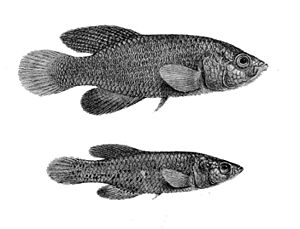Spotted killifish facts for kids
Quick facts for kids Spotted killifish |
|
|---|---|
 |
|
| Conservation status | |
| Scientific classification | |
| Synonyms | |
|
The spotted killifish (Nothobranchius orthonotus) is a small fish that lives for a short time. It belongs to a group of fish called African rivulines. These fish live in many separate freshwater pools in the grassy plains of East Africa. You can find them in countries like Malawi, Mozambique, Zimbabwe, and South Africa.
These fish live in pools that dry up completely for part of the year. Their eggs are super tough and can survive for a long time even when there is no water. The name "killifish" comes from the Dutch word kil, which means "small stream."
Contents
What Do Spotted Killifish Eat?
The spotted killifish is a hunter! It eats both small animals that live in water and tiny water creatures without backbones. Its favorite foods are young lungfish and baby amphibians, like tadpoles.
This fish also enjoys eating many insect larvae. These include larvae from dragonflies (Odonata), beetles (Coleoptera), and mayflies (Ephemeroptera). Eating these types of food helps the killifish get enough energy easily.
Life Cycle and Reproduction
Spotted killifish are amazing because they can survive in places where their homes dry up every year. This is a special skill for fish in the Nothobranchius family.
How They Grow and Reproduce
The fish hatch when the rainy season begins. They grow very, very fast. In just a few weeks, they are old enough to have their own babies. Female killifish can lay up to 50 eggs every single day!
The eggs are laid in the mud or soil at the bottom of the pool. They stay there even after the water dries up completely. The tiny fish inside the eggs can pause their growth. They wait safely in the dry ground until the next rainy season starts and the pools fill with water again.
Unique Features of the Spotted Killifish
Fish in the Nothobranchius group, including the spotted killifish, have a cool difference between males and females. This is called sexual dichromatism.
Bright Males, Dull Females
Male spotted killifish are very brightly colored. They often have amazing patterns. Female killifish, on the other hand, are usually duller in color. This helps them blend in with their surroundings.
The adult spotted killifish is one of the biggest fish in its group. It can grow to be about 10 centimeters (4 inches) long.
Where Spotted Killifish Live
The spotted killifish lives in isolated freshwater pools. These pools are found in the savannah areas of East Africa. You can find them in Malawi, Mozambique, Zimbabwe, and South Africa.
Sharing Their Home
These fish often share their pools with other types of killifish. These include N. furzeri, N. kadleci, and N. rachovii.
The places they live can be very different. Some pools are shallow with cloudy water and no plants. Others are deep with clear water and lots of plants. They might also live in swamps that sometimes connect to bigger floodplains.
Adapting to Changes
Because of their special life cycle, spotted killifish are good at handling the wet and dry seasons in Africa. However, some programs that spray for mosquitoes (to prevent malaria) and tsetse flies are affecting their populations. Even though they are facing some threats, they are not yet in serious danger and do not need special conservation efforts everywhere.
How the Spotted Killifish Got Its Name
The spotted killifish was first described in 1844. It was named Cyprinodon orthonotus by a scientist named Wilhelm Peters. He found it near Quelimane in eastern Mozambique.
The name orthonotus comes from two Greek words: orthos meaning "straight" and notus meaning "back." This name refers to the straight shape of the fish's back.
See also
- Killifish
- Banded killifish


